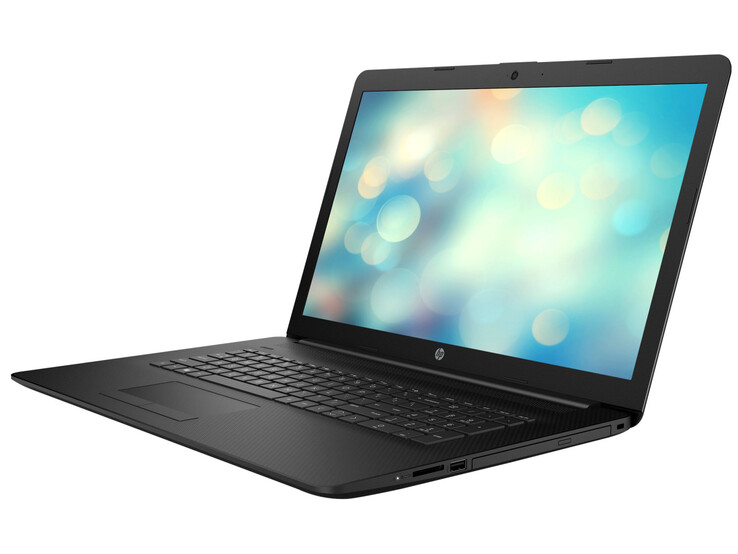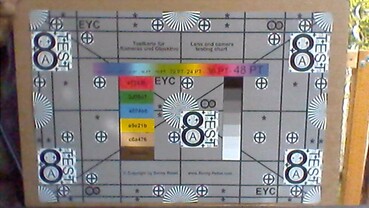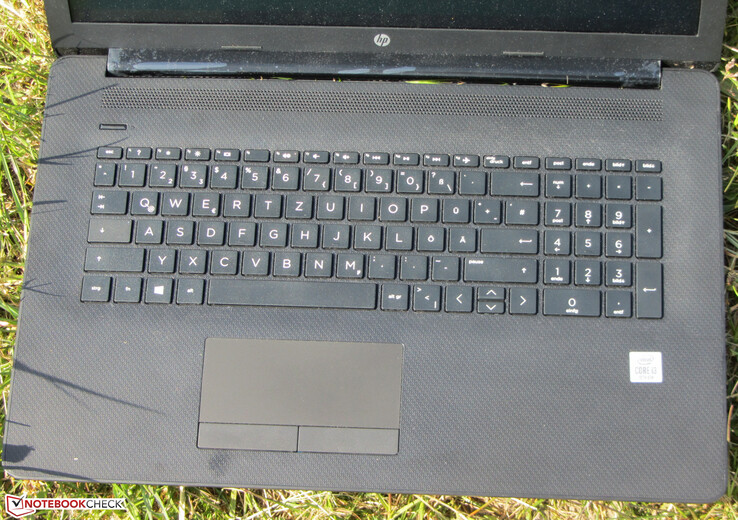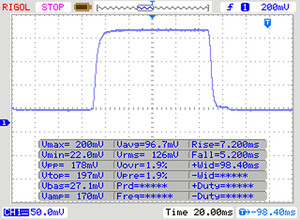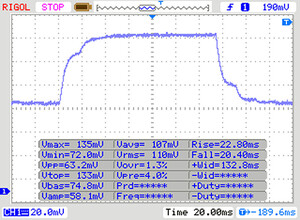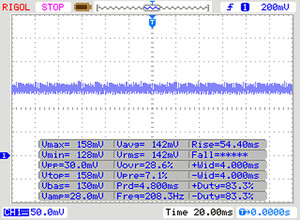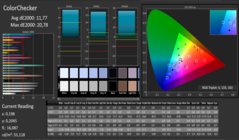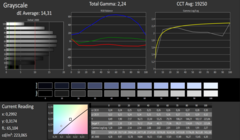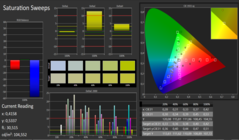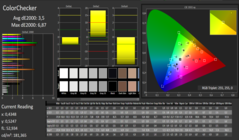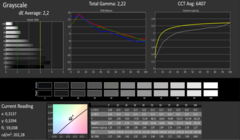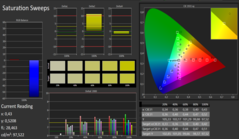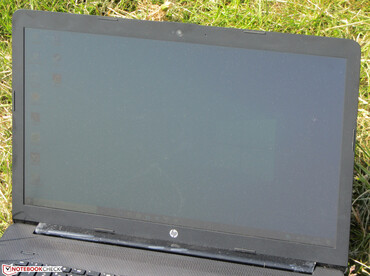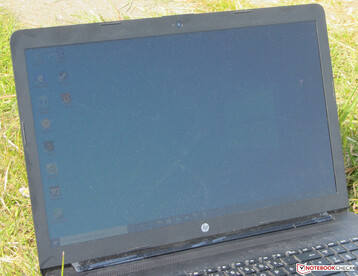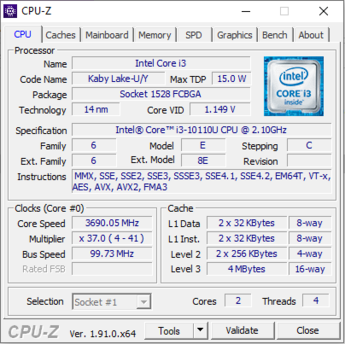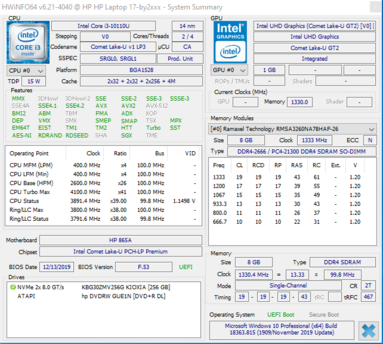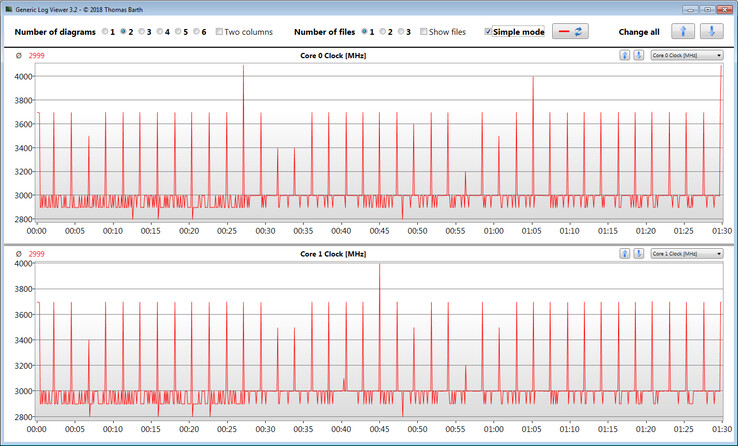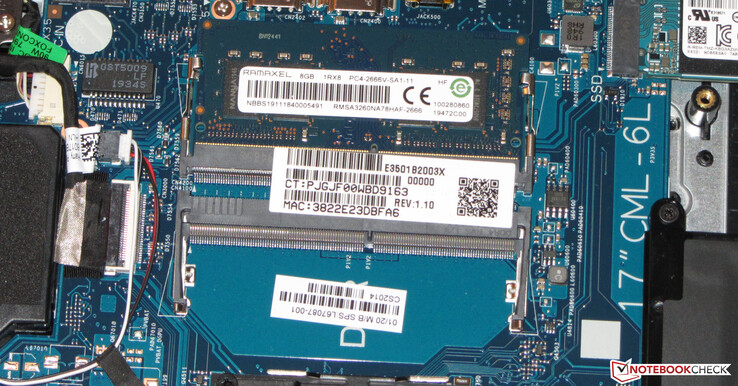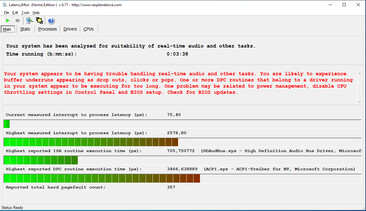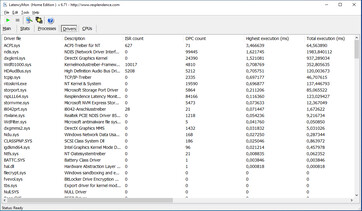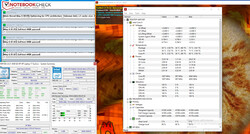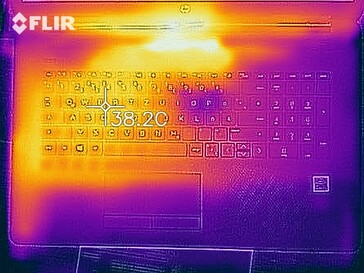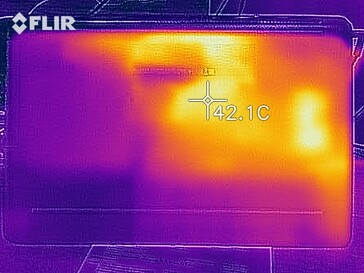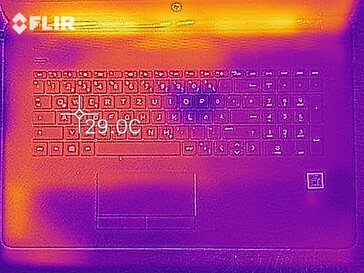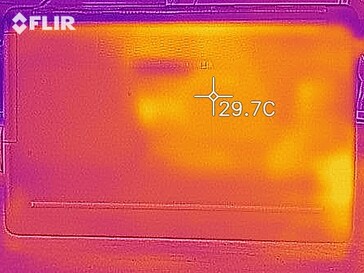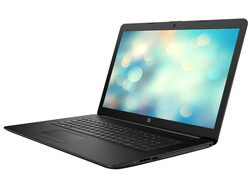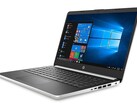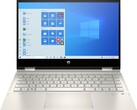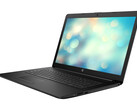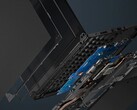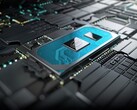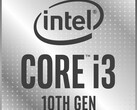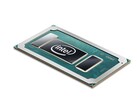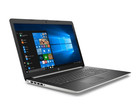HP 17 Laptop Review: A simple office notebook with a DVD burner

The HP 17 is a 17.3-inch office notebook from the lower price segment. Our test unit is run by a Core-i3 processor of the Comet Lake generation. The competitors include devices such as the Lenovo IdeaPad L340-17API and the Asus VivoBook 17 M712DA.
Rating | Date | Model | Weight | Height | Size | Resolution | Price |
|---|---|---|---|---|---|---|---|
| 75.2 % v7 (old) | 05 / 2020 | HP 17-by2437ng i3-10110U, UHD Graphics 620 | 2.4 kg | 24.5 mm | 17.30" | 1600x900 | |
| 80.8 % v6 (old) | 08 / 2019 | Lenovo Ideapad L340-17API-81LY0004GE R5 3500U, Vega 8 | 2.8 kg | 24.3 mm | 17.30" | 1600x900 | |
| 75.6 % v7 (old) | 01 / 2020 | Asus VivoBook 17 M712DA-AU017T R5 3500U, Vega 8 | 2.3 kg | 21 mm | 17.30" | 1920x1080 |
Case and Equipment - The HP 17 plastic case makes maintenance difficult
HP uses a matte-black plastic case here. With the exception of the display bezels, all the surfaces are textured (HP advertises it as "structured net pattern"). While the case does not show any faults in the workmanship, it is not one of the most robust representatives, since the lid and base unit can be warped. When pressure is applied, the base unit shows some give in several places.
It is also not very friendly in terms of maintenance. To take off the bottom of the case (there is no maintenance flap) requires removing all of the screws at the bottom - after you have taken out the optical drive. These also include the screws that hide behind the glued-on rubber bars. The bars have to be pulled off carefully to prevent their ripping. Afterwards, the bottom can be removed with the help of a flat prying tool.
The laptop does not offer any surprises in terms of the connections. The three USB Type-A connections (1x USB 2.0, 2x USB 3.2 Gen 1) are accompanied by an HDMI port, an audio-combo port, and a Gigabit Ethernet port.
SD cards almost disappear completely (~4 mm = 0.16 inches still sticks out) in the storage card reader. With maximum transfer rates of 33.9 MB/s (transferring 250 jpg image files of around 5 MB each) and 36.2 MB/s (copying large data blocks), it is one of the slower models. We test the card readers using a reference storage card (Toshiba Exceria Pro SDXC 64 GB UHS-II).
The Realtek WLAN chip (RTL8723DE) supports the 802.11b/g/n WLAN standards. The transfer speed measured under optimal conditions (no additional WLAN devices in close proximity, close distance between laptop and server PC) turns out to be poor.
Connection Equipment
| SD Card Reader | |
| average JPG Copy Test (av. of 3 runs) | |
| Average of class Office (22.4 - 198.5, n=28, last 2 years) | |
| Asus VivoBook 17 M712DA-AU017T (Toshiba Exceria Pro M501 microSDXC 64GB) | |
| HP 17-by2437ng (Toshiba Exceria Pro SDXC 64 GB UHS-II) | |
| maximum AS SSD Seq Read Test (1GB) | |
| Average of class Office (25 - 249, n=26, last 2 years) | |
| Asus VivoBook 17 M712DA-AU017T (Toshiba Exceria Pro M501 microSDXC 64GB) | |
| HP 17-by2437ng (Toshiba Exceria Pro SDXC 64 GB UHS-II) | |
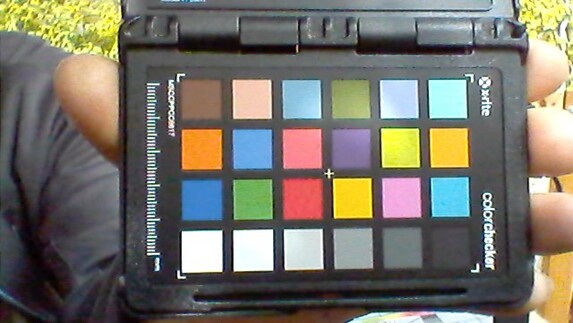
Input Devices - No keyboard illumination for the HP computer
The keys of the chiclet keyboard offer a medium stroke and clear pressure point. We like the resistance of the keys. While typing, the keyboard offers some minimal give, but this did not turn out to be much of a hindrance. Overall, HP has delivered a keyboard suitable for everyday tasks here. The multi-touch capable touchpad has a footprint of about 11.5 x 5.1 cm (~4.5 x 2 in). The smooth surface does not prevent fingers from sliding easily. The pad is also responsive to input in the corners. The two separate mouse keys have a short stroke and clear pressure point.
Display - It could not be much worse
The matte 17.3-inch display has a native resolution of 1600x900 pixels. The brightness (207.9 cd/m² in mains operation and 187 cd/m² in battery operation) and contrast (342:1) are unable to produce any enthusiasm. We consider values above 300 cd/m² and 1000:1 as good.
At a brightness level of 80% or below, the display shows some flickering with a frequency of 250 Hz. This low frequency might cause some headaches or eye problems in more sensitive people.
| |||||||||||||||||||||||||
Brightness Distribution: 89 %
Center on Battery: 187 cd/m²
Contrast: 342:1 (Black: 0.649 cd/m²)
ΔE ColorChecker Calman: 11.77 | ∀{0.5-29.43 Ø4.78}
calibrated: 3.5
ΔE Greyscale Calman: 14.31 | ∀{0.09-98 Ø5}
74% sRGB (Argyll 1.6.3 3D)
48% AdobeRGB 1998 (Argyll 1.6.3 3D)
53.9% AdobeRGB 1998 (Argyll 3D)
74% sRGB (Argyll 3D)
53.6% Display P3 (Argyll 3D)
Gamma: 2.24
CCT: 19250 K
| HP 17-by2437ng TN LED, 1600x900, 17.3" | Lenovo Ideapad L340-17API-81LY0004GE TN LED, 1600x900, 17.3" | Asus VivoBook 17 M712DA-AU017T IPS, 1920x1080, 17.3" | |
|---|---|---|---|
| Display | -2% | -22% | |
| Display P3 Coverage (%) | 53.6 | 51.1 -5% | 40.76 -24% |
| sRGB Coverage (%) | 74 | 73.9 0% | 59.7 -19% |
| AdobeRGB 1998 Coverage (%) | 53.9 | 52.7 -2% | 42.11 -22% |
| Response Times | 4% | -4% | |
| Response Time Grey 50% / Grey 80% * (ms) | 42 ? | 42 ? -0% | 24 ? 43% |
| Response Time Black / White * (ms) | 12 ? | 11 ? 8% | 18 ? -50% |
| PWM Frequency (Hz) | 250 ? | ||
| Screen | 9% | 34% | |
| Brightness middle (cd/m²) | 222 | 230 4% | 262 18% |
| Brightness (cd/m²) | 208 | 201 -3% | 234 13% |
| Brightness Distribution (%) | 89 | 78 -12% | 84 -6% |
| Black Level * (cd/m²) | 0.649 | 0.46 29% | 0.265 59% |
| Contrast (:1) | 342 | 500 46% | 989 189% |
| Colorchecker dE 2000 * | 11.77 | 10.36 12% | 5.13 56% |
| Colorchecker dE 2000 max. * | 20.78 | 18.63 10% | 19.16 8% |
| Colorchecker dE 2000 calibrated * | 3.5 | 3.96 -13% | |
| Greyscale dE 2000 * | 14.31 | 13.32 7% | 1.22 91% |
| Gamma | 2.24 98% | 2.54 87% | 2.42 91% |
| CCT | 19250 34% | 14124 46% | 6584 99% |
| Color Space (Percent of AdobeRGB 1998) (%) | 48 | 48 0% | 38 -21% |
| Color Space (Percent of sRGB) (%) | 74 | 74 0% | 59 -20% |
| Total Average (Program / Settings) | 4% /
6% | 3% /
19% |
* ... smaller is better
Display Response Times
| ↔ Response Time Black to White | ||
|---|---|---|
| 12 ms ... rise ↗ and fall ↘ combined | ↗ 7 ms rise | |
| ↘ 5 ms fall | ||
| The screen shows good response rates in our tests, but may be too slow for competitive gamers. In comparison, all tested devices range from 0.1 (minimum) to 240 (maximum) ms. » 30 % of all devices are better. This means that the measured response time is better than the average of all tested devices (20.2 ms). | ||
| ↔ Response Time 50% Grey to 80% Grey | ||
| 42 ms ... rise ↗ and fall ↘ combined | ↗ 22 ms rise | |
| ↘ 20 ms fall | ||
| The screen shows slow response rates in our tests and will be unsatisfactory for gamers. In comparison, all tested devices range from 0.165 (minimum) to 636 (maximum) ms. » 66 % of all devices are better. This means that the measured response time is worse than the average of all tested devices (31.6 ms). | ||
Screen Flickering / PWM (Pulse-Width Modulation)
| Screen flickering / PWM detected | 250 Hz | ≤ 80 % brightness setting | |
The display backlight flickers at 250 Hz (worst case, e.g., utilizing PWM) Flickering detected at a brightness setting of 80 % and below. There should be no flickering or PWM above this brightness setting. The frequency of 250 Hz is relatively low, so sensitive users will likely notice flickering and experience eyestrain at the stated brightness setting and below. In comparison: 53 % of all tested devices do not use PWM to dim the display. If PWM was detected, an average of 8095 (minimum: 5 - maximum: 343500) Hz was measured. | |||
The color reproduction in the state of delivery is not convincing. A DeltaE-2000 deviation of almost 12 clearly misses the target range of DeltaE smaller than 3. In addition, the display suffers from a clear blue tint. Calibration brings some improvement, lowering the color deviation to 3.5, removing the blue tint, and displaying a more balanced grayscale. The screen is unable to display the AdobeRGB (48%) and sRGB (74%) color spaces.
HP has equipped the 17.3-inch notebook with a TN panel that does not offer stable viewing angles. This means that the display cannot be read from any position. Outdoors, you can only read the display when the sun is not shining. The maximum display brightness, which is already low, drops even further in battery operation (187 cd/m²).
Performance - An HP laptop with a Core i3
With the 17-by2437ng, Hewlett Packard offers a simple 17.3-inch office notebook that offers sufficient computing performance for office and Internet applications. Our test unit is available for about 450 Euros (~$487). Other equipment models are also available.
Processor
The HP 17 is run by an Intel Core i3-10110U (Comet Lake) dual-core processor. The CPU has a basic clock speed of 2.1 GHz, which can be increased up to 4.1 GHz via Turbo. Hyper-Threading (running two threads per core) is supported.
The processor runs through the multithread tests of the Cinebench benchmarks at 3.7 GHz for a short time, before the clock speed drops to 2.9 - 3 GHz. During the single-thread tests, it runs at 3.7 - 4.1 GHz. The behavior is identical in mains and battery operation.
We evaluate whether the CPU Turbo can be maintained constantly by letting the multithread test of the Cinebench-R15 benchmarks run for at least 30 minutes in a loop. From the first to the second run the results drop slightly and then remain at a constant level. The CPU Turbo is used.
| Blender - v2.79 BMW27 CPU | |
| HP 17-by2437ng | |
| Average Intel Core i3-10110U (1174 - 1385, n=2) | |
| Average of class Office (158 - 1956, n=80, last 2 years) | |
| Geekbench 4.4 | |
| 64 Bit Single-Core Score | |
| Average of class Office (4469 - 8042, n=11, last 2 years) | |
| HP 17-by2437ng | |
| Average Intel Core i3-10110U (n=1) | |
| Lenovo Ideapad L340-17API-81LY0004GE | |
| 64 Bit Multi-Core Score | |
| Average of class Office (16566 - 41544, n=11, last 2 years) | |
| Lenovo Ideapad L340-17API-81LY0004GE | |
| HP 17-by2437ng | |
| Average Intel Core i3-10110U (n=1) | |
| HWBOT x265 Benchmark v2.2 - 4k Preset | |
| Average of class Office (1.72 - 26, n=78, last 2 years) | |
| Average Intel Core i3-10110U (2.72 - 3.12, n=2) | |
| HP 17-by2437ng | |
| LibreOffice - 20 Documents To PDF | |
| HP 17-by2437ng | |
| Average of class Office (41.5 - 129.6, n=78, last 2 years) | |
| Average Intel Core i3-10110U (28.1 - 65.4, n=2) | |
| R Benchmark 2.5 - Overall mean | |
| Average Intel Core i3-10110U (0.74 - 0.76, n=2) | |
| HP 17-by2437ng | |
| Average of class Office (0.4098 - 1.06, n=78, last 2 years) | |
| Mozilla Kraken 1.1 - Total | |
| Average Intel Core i3-10110U (1220 - 1268, n=2) | |
| Lenovo Ideapad L340-17API-81LY0004GE (Edge 44) | |
| HP 17-by2437ng (Edge 44) | |
| Average of class Office (391 - 1297, n=80, last 2 years) | |
| Octane V2 - Total Score | |
| Average of class Office (59450 - 122119, n=18, last 2 years) | |
| HP 17-by2437ng (Edge 44) | |
| Average Intel Core i3-10110U (n=1) | |
| Lenovo Ideapad L340-17API-81LY0004GE (Edge 44) | |
| JetStream 1.1 - Total Score | |
| HP 17-by2437ng (Edge 44) | |
| Average Intel Core i3-10110U (n=1) | |
| Lenovo Ideapad L340-17API-81LY0004GE (Edge 44) | |
| Asus VivoBook 17 M712DA-AU017T | |
* ... smaller is better
System Performance
The system runs fluidly and smoothly. The 17.3-inch laptop offers sufficient performance for applications in the office and Internet areas. A slight increase of the overall performance could be achieved by adding a second working memory module (= active dual-channel mode).
| PCMark 8 Home Score Accelerated v2 | 3116 points | |
| PCMark 8 Creative Score Accelerated v2 | 3005 points | |
| PCMark 8 Work Score Accelerated v2 | 4764 points | |
| PCMark 10 Score | 3542 points | |
Help | ||
| PCMark 8 - Home Score Accelerated v2 | |
| Average of class Office (n=1last 2 years) | |
| Lenovo Ideapad L340-17API-81LY0004GE | |
| HP 17-by2437ng | |
| Average Intel Core i3-10110U, Intel UHD Graphics 620 (2898 - 3116, n=2) | |
DPC Latencies
| DPC Latencies / LatencyMon - interrupt to process latency (max), Web, Youtube, Prime95 | |
| HP 17-by2437ng | |
* ... smaller is better
Storage Solution
| HP 17-by2437ng Toshiba KBG30ZMV256G | Lenovo Ideapad L340-17API-81LY0004GE Samsung SSD PM871b MZ7LN256HAJQ | Asus VivoBook 17 M712DA-AU017T Intel SSD 660p SSDPEKNW512G8 | Average Toshiba KBG30ZMV256G | Average of class Office | |
|---|---|---|---|---|---|
| CrystalDiskMark 5.2 / 6 | -37% | 15% | -3% | 170% | |
| Write 4K (MB/s) | 126.7 | 94.4 -25% | 132 4% | 114.9 ? -9% | 155.6 ? 23% |
| Read 4K (MB/s) | 52.5 | 32.45 -38% | 52 -1% | 48 ? -9% | 73.4 ? 40% |
| Write Seq (MB/s) | 669 | 482.8 -28% | 973 45% | 727 ? 9% | 2675 ? 300% |
| Read Seq (MB/s) | 881 | 524 -41% | 1606 82% | 885 ? 0% | 3233 ? 267% |
| Write 4K Q32T1 (MB/s) | 272.2 | 232 -15% | 210.4 -23% | 253 ? -7% | 420 ? 54% |
| Read 4K Q32T1 (MB/s) | 483.5 | 253.6 -48% | 312.2 -35% | 400 ? -17% | 519 ? 7% |
| Write Seq Q32T1 (MB/s) | 796 | 496.5 -38% | 982 23% | 849 ? 7% | 3954 ? 397% |
| Read Seq Q32T1 (MB/s) | 1503 | 540 -64% | 1847 23% | 1493 ? -1% | 5641 ? 275% |
Graphics Card
The graphics output is handled by Intel's UHD Graphics 620 graphics core. The GPU supports DirectX 12 and runs at speeds between 300 and 1000 MHz. The results in the 3DMark benchmarks range at a normal level for the graphics core used here.
| 3DMark 11 Performance | 1619 points | |
| 3DMark Ice Storm Standard Score | 54076 points | |
| 3DMark Cloud Gate Standard Score | 6113 points | |
| 3DMark Fire Strike Score | 895 points | |
| 3DMark Time Spy Score | 361 points | |
Help | ||
| 3DMark 11 - 1280x720 Performance GPU | |
| Average of class Office (1468 - 16418, n=73, last 2 years) | |
| Lenovo Ideapad L340-17API-81LY0004GE | |
| Average Intel UHD Graphics 620 (1144 - 3432, n=244) | |
| HP 17-by2437ng | |
Gaming Performance
The hardware of the HP notebook is able to bring some games to the screen smoothly - at low resolution and low quality settings. This includes games that only place moderate demands on the hardware. The frame rates could be increased by activating the dual-channel mode (= inserting a second working memory module). However, you would still be unable to play current demanding games such as Doom Eternal.
| low | med. | high | ultra | |
|---|---|---|---|---|
| BioShock Infinite (2013) | 44.9 | 26.4 | 22 |
| BioShock Infinite - 1280x720 Very Low Preset | |
| Lenovo Ideapad L340-17API-81LY0004GE | |
| Average Intel UHD Graphics 620 (18.3 - 90.2, n=187) | |
| HP 17-by2437ng | |
Emissions and Power Management - The HP 17 runs quietly and hardly heats up
Noise Emissions
During idle operation, the fan runs constantly at a low speed. Once again, HP's own "Fan Always On" BIOS option is responsible for this. After this is deactivated, the fan is often turned off during idle operation. However, some small load is often enough to turn on the fan. Under full load, it only revs up slightly. We measure a noise level of 33 dB(A) during the stress test. Using the DVD drive creates more noise.
Noise level
| Idle |
| 31.4 / 31.4 / 31.4 dB(A) |
| DVD |
| 38.7 / dB(A) |
| Load |
| 32.6 / 33 dB(A) |
 | ||
30 dB silent 40 dB(A) audible 50 dB(A) loud |
||
min: | ||
Temperatures
The HP laptop runs through our stress test (Prime95 and FurMark running for at least one hour) in the same way in battery or mains operation. The processor runs for several seconds at 3.5 GHz, and then the clock speed drops to 1.1 GHz. The graphics core is throttled from the initial 1000 MHz down to 800 MHz. The stress test represents an extreme scenario that does not occur during everyday operation. We use this test to evaluate whether the system also remains stable under full load.
The heat development of the laptop is very limited. We measure temperatures clearly below 40 °C (104 °F). The values turn out even lower during everyday operation.
(+) The maximum temperature on the upper side is 34.6 °C / 94 F, compared to the average of 34.3 °C / 94 F, ranging from 21.2 to 62.5 °C for the class Office.
(+) The bottom heats up to a maximum of 37.1 °C / 99 F, compared to the average of 36.8 °C / 98 F
(+) In idle usage, the average temperature for the upper side is 25.1 °C / 77 F, compared to the device average of 29.5 °C / 85 F.
(+) The palmrests and touchpad are cooler than skin temperature with a maximum of 26.1 °C / 79 F and are therefore cool to the touch.
(±) The average temperature of the palmrest area of similar devices was 27.6 °C / 81.7 F (+1.5 °C / 2.7 F).
Speakers
The stereo speakers are placed above the keyboard behind a perforated cover. They produce a fairly decent but to a large extent bass-free sound.
HP 17-by2437ng audio analysis
(-) | not very loud speakers (71.5 dB)
Bass 100 - 315 Hz
(-) | nearly no bass - on average 23.9% lower than median
(±) | linearity of bass is average (10.4% delta to prev. frequency)
Mids 400 - 2000 Hz
(±) | higher mids - on average 5.6% higher than median
(±) | linearity of mids is average (12.9% delta to prev. frequency)
Highs 2 - 16 kHz
(±) | higher highs - on average 5% higher than median
(+) | highs are linear (5.6% delta to prev. frequency)
Overall 100 - 16.000 Hz
(±) | linearity of overall sound is average (25.3% difference to median)
Compared to same class
» 76% of all tested devices in this class were better, 7% similar, 17% worse
» The best had a delta of 7%, average was 21%, worst was 53%
Compared to all devices tested
» 77% of all tested devices were better, 5% similar, 18% worse
» The best had a delta of 4%, average was 24%, worst was 134%
Power Consumption
Over the whole range of loads, the power consumption remains on a normal level for the hardware used here. During idle operation, we measure a power consumption of 9 watts. During the stress test (Prime95 and FurMark run for at least one hour), the value increases up to 30.5 watts. The power supply is rated at 45 watts.
| Off / Standby | |
| Idle | |
| Load |
|
Key:
min: | |
Battery Life
Using a script, our realistic WLAN test simulates the load when loading websites. The "Balanced" power profile is activated, the brightness is set at about 150 cd/m², and the power-saving functions are turned off. The HP 17 achieves a runtime of 5:39 h.
| Battery Runtime - WiFi Websurfing | |
| Average of class Office (3.83 - 31.5, n=81, last 2 years) | |
| Lenovo Ideapad L340-17API-81LY0004GE | |
| HP 17-by2437ng | |
| Asus VivoBook 17 M712DA-AU017T | |
Pros
Cons
Verdict
With the HP 17, Hewlett Packard delivers a simple office notebook with a Core-i3 processor that supplies sufficient computing power for office and Internet applications. It is surprising that the CPU is unable to run constantly at full Turbo speed in multithread operation. On the positive side: The laptop runs mostly quietly and heats up moderately at most.
The HP 17-by2437ng represents a solid office laptop that is not up to date in all aspects.
An SSD ensures a smoothly running system. To replace it with a higher-capacity model would require opening the case. Users who want an optical drive should be pleased with the DVD burner. The built-in keyboard turned out to be suitable for everyday tasks, and the battery life is also decent.
The display won't win any prizes. HP has equipped the laptop with a dark HD+ display with low contrast and unstable viewing angles. The notebook also delivers bad WLAN data rates, since the WLAN chip only supports the 802.11n standard. While it does not absolutely have to be a WiFi-6 chip (802.11ax) in a laptop of this price range, we would expect a Wi-Fi-5 model (802.11ac) in 2020. In addition, HP only offers a one-year warranty for the laptop.
While a Windows operating system is not included, Windows 10 could be installed without any problems. Alternatively, you could also use Linux. A brief test with Ubuntu 20.04 LTS did not reveal any problems. The whole hardware works - including the Function keys.
HP 17-by2437ng
- 05/13/2020 v7 (old)
Sascha Mölck




